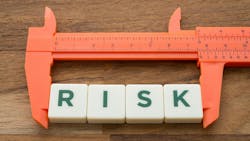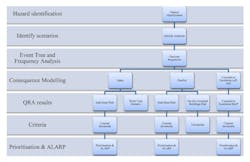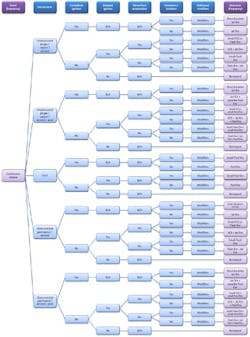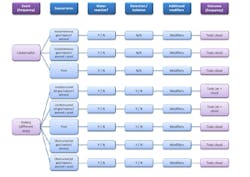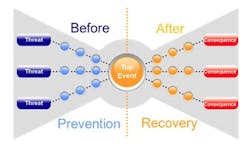Resources
CAMEO Suite (Computer Aided Management of Emergency Operations) is available as a free download from the USEPA. It includes a hazardous chemical database, a graphic information system, an emergency database for planning, and information on TIER II Chemical Inventory reporting. ALOHA is also a part of the CAMEO suite and will calculate some but not all the requirements of the Government of Singaphore.
In part one of this series, we investigated the history and rationale behind quantitative risk analysis (QRA), a systematic approach to assessing and quantifying risks in industrial settings. Developed in response to major industrial incidents, QRA transforms risk perception from subjective to measurable data.
There are various QRA assessment tools, modeling software and harm criteria out there that can be helpful as you embark on your risk assessments. Let’s look at a few approaches and resources.
Singapore’s Approach
The government of Singapore has very comprehensive guidance documents and requirements for preparation for QRA. The requirements include analysis of consequences from total and partial loss of containment (LOC) for tanks and pipelines; boiling liquid expanding vapor explosions (BLEVEs); operational and process errors (mischarging or overfilling tanks); bulk transport and pipeline incidents and alarm failures leading to incidents. One must assess the potential number of casualties from pool fires, jet fires, flash fires, vapor cloud explosions, pressure vessel failures, runaway reactions, failures of firewalls, blast walls and toxic releases. Many of these scenarios can be ruled out based on the material properties.
Most toxic release incidents generate air pollutants. The Singapore QRA requirements include evaluating upwind (back spreading) contamination and downwind toxic profiles and provisions to reduce emission exposure to levels that are “as low as reasonably possible” (ALRAP).
A QRA requires evaluating the consequences of a release scenario. Several consulting firms have developed models that automate this process, and they advertise that they can provide complete services for QRA preparation through their use. If the project is complex, the costs will be several thousand dollars.
Hazard Assessment Resources
In the United States, a popular scenario generation site is ALOHA (Area Locations of Hazardous Atmospheres), developed by the U.S. Environmental Protection Agency as part of CAMEO (Computer-Aided Management of Emergency Operations). Some states use it for hazard assessment in school sites. ALOHA can predict the downwind effects of toxic chemicals and the associated exposure hazard, but it does not quantify the likelihood of fatalities.
The EPA has risk assessment guidelines that include specific health-based recommendations, remediation, ionizing radiation, radon, air pollution and other factors. The guidelines do not address frequency issues for industrial incidents or provide much guidance on risk factors and frequencies .
RAST by AIChE and CCPS for Hazard Identification
The EPA, the Center for Chemical Process Safety (CCPS) and AIChE have developed RAST (Risk Analysis Screening Tool), a free Excel-based hazard identification system for screening for process hazards. The program requires significant chemical data.
An associated program, Chemical Hazards Engineering Fundamentals (CHEF), is available through AIChE. The CHEF program includes the identification of chemical and operational hazards and suggestions for scenario development; source models for estimation of leak rate, evaporation rate, vapor dispersion and explosions; effect models for estimation of human harm from toxic releases, flammable releases and explosions; techniques for evaluation of likelihood (historical data, fault tree and event tree); and quantification of risk. The demonstration slides that discuss CHEF and what it can do are quite informative.
How to Prepare a QRA
The Government of Singapore has a guide (see endnote i), which we will highlight because it has good graphics.
The first task is to identify the hazard (see Figure 1). The consequences could include injury to people, fatalities (on and offsite) and potential escalation into other events.
The second step is to identify a scenario(s): The first scenario involves the release of a large ammonia cloud from the failure of one of two refrigerated storage tanks in central California. The second scenario involves a leak of liquefied chlorine from a rail car near Atlanta.
If one of the California ammonia tanks loses containment, it will release large quantities of liquid ammonia into a 250-ft x 510-ft dike approximately 5-ft high and create a large vapor plume. The chlorine tank is located in a rail yard northwest of Atlanta and creates a dense gas toxic plume. These scenarios will be presented in the next section. A QRA must provide consequence-based results, including the distances and specific harm levels and frequencies in the harm zones.
The third step is an event tree and frequencies. The event tree (see Figure 2) is from the Singapore guidance document.
The event tree has been reduced (see Figure 3) to eliminate fire as a possibility. The concern is asphyxia and inhalation of either chlorine or ammonia.
Modeling the consequences of individual exposures is required for each case.
Potential Incident Effects Modifiers
The potential modifiers to any incident scenario include mechanical provisions, equipment and alarms that will provide early warning of a hazard. These provisions are addressed in the development of a bow tie analysis (see Figure 4).
The diagram tends to be self-explanatory. The overall format is hazards and problems on the left, with solutions and modifiers on the right.
Models and Modeling
Several models can be used to evaluate disaster consequences. There are some pollution programs for air releases from the EPA. Some of the EPA environmental models:
- Risk-Screening Environmental Indicators (RSEI) Model — a model for screening environmental indicators.
- Air quality dispersion modeling - Screening Models — includes: AERSCREEN, CALC3QHC, COMPLEX1, CTSCREEN, TSCREEN, VALLEY AND VISCREEN. The page provides access and documentation for the models.
- Predictive models and tools for assessing chemicals under the Toxic Substances Control Act (TSCA) — primarily a set of tools useful in screening chemicals listed under TSCA.
- BLEVE fireball modeling using Fire Dynamics Simulator (FDS) in an Algerian gas industry — contains a description of BLEVE and Fireball Dynamics using CFD.
- Fire Dynamics Simulator (FDS) and Smokeview (SMV) — links to the Fire Dynamics Simulator for smoke and heat transport from the National Institute of Standards and Technology.
- CAMEO Software Suite (link to ) — good for planning responses.
- Water Quality Analysis Simulation Program (WASP) — water quality model for multiple pollutants.
- An improved model for the prediction of radiant heat from fireballs — Quest Consultants have a program for modeling the heat flux from fireballs. Commercially available.
The Singapore QRA lists the following models: DNV PHAST; TNO Effects; CERC ADAMS; Shell Global Solutions FRED; BP CIRRUS; and SAFER TRACE as approved evaluation models.
Useful Considerations
For toxic probits, use the green book (the Economic Commission for Europe, the UK government and the Dutch government — Methods for Determination of Possible Damage to people and objects from the release of hazardous Materials) and consider 10% and 50% fatalities. Considerations must include potential fatalities unsheltered (outside).
Air Modeling: Consider nighttime and daytime conditions, including high stability, high humidity and wind rose, to determine the probability of wind variability in different directions. High stability, high humidity and nighttime conditions are the most severe.
Singapore Harm Criteria
Harm Footprints must consider: 3%,10% and 50% fatalities from toxic releases, Radiation Exposures range from 4kW/m2 to 37.5kW/m2; Acceptable level 3*10-7/year.
Overpressures from an explosion must be evaluated at 5 and 10 psi. Harm footprints must be modeled for all incident and weather conditions, including fireballs and vapor cloud explosions.
Cumulative Outcomes for all categories for fixed installations: 10-4/yr.
Occupied Buildings onsite: consider the time the structure is occupied: 10-3/yr.
Potential Loss of Life occupied buildings: factor in Radiation Value * occupancy.
Rank Harm Criteria Scenarios based on frequencies of 10-5 to <10-8/per year, and measure the offsite damage in 106 dollar increments from $2M to over $2000M ($1.524 million to $1.542 billion).
The harm/risk criteria for exposures should be ALARP for each scenario.
Alternatives for Risk Reduction must be identified, including substitution alternatives for hazardous or flammable chemicals.
Further Risk Reduction Measures should include shutdown systems, improved specifications and physical controls similar to those in PSM alternatives.
Emergency Action Plans and Response Plans should be developed and implemented, and they should include evacuation, prepositioning of supplies and emergency response services.
Modifier Based on Cost
The estimate of the cost to achieve ALARP exposure can be estimated from:
Cost Multiplier = A multiplier that ensures that cost outweighs the benefits 1<CM<10
The benefit of injuries may be factored in considering the remaining lifetime of injured persons and the benefits of avoided damage and escalation costs as described in the Singapore QRA Guide. ⊕
About the Author
Dave Russell
PE, ASP, president, Global Environmental Operations Inc.
Dave is a PE and Associate Safety Professional who practices from his company Global Environmental Operations Inc. He has lectured and consulted on environmental and safety issues all over the world.
